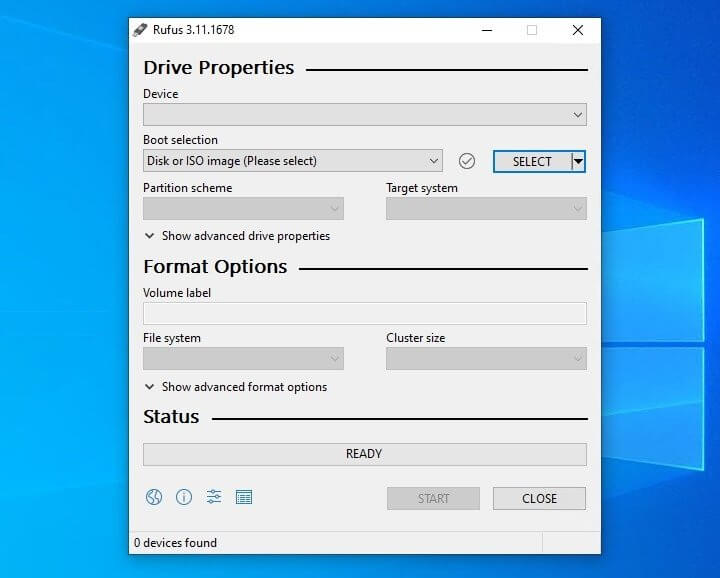Rufus 4.4 Crack + Keygen Latest Version Free Download for Windows

Rufus Crack is an open source utility for Windows that allows users to format and initialize a USB drive. With this simple program you can convert a bootable USB flash drive.
Rufus Portable is a USB formatting program that creates bootable USB drives using bootable ISO images. This application requires administrator privileges.
Rufus Full Version is a small utility that helps you format and create bootable USB flash drives such as USB keys/sticks, memory cards and more. And it makes life easier for everyone because we all go through the profile panel offered by Windows. From the interface you can easily select the required disks and partition schemes.
You can also select the target system type and file system type. Advanced mods can convert Rufus to a fixed (non-flash) or unallocated USB flash drive, apply patches for older BIOSes, and use Rufus MBR with the selected BIOS ID.
Rufus Crack is a versatile utility that offers easy-to-use functions for formatting and creating bootable USB flash drives. If you need a bootable ISO USB boot device to run on systems that do not have an installed operating system, DOS firmware, or running low-level utilities, we provide it.
One of the main advantages of Rufus is the ability to create bootable USB drives with different operating systems such as Windows, Linux and UEFI. This makes it a valuable tool for system administrators, technology enthusiasts, and those who frequently work with bootable media.
If you are creating a DOS boot drive and using a non-US keyboard, it will automatically detect the system base and select the appropriate keyboard layout. It should be noted that FreeDOS is a more recommended option than MS-DOS as it supports a wider range of keyboard layouts.
To create an ISO image from a physical disc or file, you can use a third-party CD burner such as InfraRecorder or CDBurnerXP. These programs work great with software that allows you to easily create ISO images.
Rufus Crack is available for free and can be easily downloaded from its official website or from FileHorse. The latest version ensures smooth user experience and provides offline setup for Windows PC.
In short, it simplifies the formatting and initialization process of creating USB drives. It serves a variety of purposes, from installing the operating system to updating the firmware, while providing an easy-to-use interface. Whether you’re a beginner or an experienced user, Rufus is a reliable choice for all your USB-related needs.
Rufus 2024 is a small utility that helps you format and create USB flash drives. This can be particularly useful:
- You need to create a USB installation media from the bootable ISO (Windows, Linux, UEFI, etc.).
- You must be working on a system that does not have an operating system installed
- You need to update BIOS or other DOS firmware
- You want to run a low-level utility
- Despite its small size, Rufus offers everything you need!
An incomplete list of ISOs Rufus works with:
Arch Linux, Archbang, BartPE/pebuilder, CentOS, Damn Small Linux, Fedora, FreeDOS, Gentoo, gNewSense, Hiren’s Boot CD, LiveXP, Knoppix, Kubuntu, Linux Mint, NT Password Registry Editor, OpenSUSE, Parted Magic, Slackware, Tails, Trinity Rescue Kit, Ubuntu, Ultimate Boot CD, Windows XP (SP2 or later), Windows Server 2003 R2, Windows Vista, Windows 7, Windows 8, Windows 10, Windows 11 and more.
Oh, and Rufus quickly. For example, it is twice as fast as UNetbootin, Universal USB Installer, or the Windows 7 USB Download Tool to create a Windows 7 USB drive installation from ISO. Creating a bootable Linux USB from the ISO is also a little faster.
Features & Highlights:
- Create a bootable USB drive using a bootable ISO image.
- Help format and create bootable USB drives such as USB flash drives, memory cards, etc.
- Format USB, flash card and virtual disk to FAT/FAT32/NTFS/UDF/exFAT/ReFS
- You can create a bootable USB DOS drive using FreeDOS or MS-DOS
- Can create BIOS or UEFI boot drives, including NTFS UEFI boot
- Create a bootable disk from an easy-to-boot ISO (Windows, Linux, Mac, etc.)
- You can create a bootable disk from a bootable disk image, including compressed files.
- Twice as fast as Microsoft USB/DVD devices or UNetbootin ISO -> USB Creation (1)
- Perform bad block checks, including detection of “rogue” flash drives.
- Calculate MD5, SHA-1 and SHA-256 checks for the selected image
- Modern, familiar user interface with native support for 35+ languages.
- Update BIOS or other DOS firmware
Formatting the USB drive
It provides a simple and efficient way to format USB drives, including support for FAT32, NTFS, exFAT, UDF and ReFS file systems. It also offers quick profile options for faster processing.
Creating a bootable USB.
It allows users to create USB drives from ISO, IMG or DD image files. It is compatible with BIOS and UEFI and can be used for various hardware configurations.
Choosing a Partition Scheme and File System
With this tool, users can select the appropriate partition scheme (MBR or GPT) and file system for the USB drive, ensuring compatibility with the desired operating system.
Validation of ISO images
The program has the option to check the authenticity of the ISO file before creating a bootable USB drive, reducing the risk of errors during the installation process.
Portable and lightweight
Rufus is a compact application that requires no installation and is easy to use anywhere. It consumes minimal system resources and runs efficiently on older hardware.

Pros:
- Simple and intuitive user interface.
- It supports a wide range of operating systems and file systems.
- It offers advanced options for power users, such as ISO authentication.
- Lightweight and portable, it is perfect for use anywhere.
- Free and open source, it guarantees continuous community support and updates.
Cons:
- Compatibility is limited with macOS and Linux.
- It cannot create a bootable USB drive for macOS.
- Some advanced features may be complicated for novice users.
- Does not support creating bootable USB drives from custom or non-standard image formats.
What’s New?
- Added a fix for deployment using broken symlinks as UEFI bootloader (e.g. Mint 21.3)
- Added support for GRUB 2.12.
- Fixed crashes when saving .ffu images
- UEFI Fix: NTFS partition not added as MBR for some Linux ISOs
- Avoid registering Microsoft Dev Drives
- Improved support for SDXC card readers
- Large-scale FAT32 update aligning data area initialization to 1MB
Rufus 4.3 release notes:
- Added support for saving the Rock Ridge symbolic link when using NTFS.
- Added exception to NTFS implementation for LMDE on Linux Mint
- Added specialized features for configuring Windows installation in S mode
- Fixed persistent boot support in Debian 12 BIOS mode
- Fixed a bug that prevented .vhd images from opening.
- Update UEFI:NTFS bootmgr to report more specific security issues
- Improves conflict detection by running it in a chain in the background
- Improved support for Slax Linux
Rufus 4.2 release notes:
- Added invalid detection and warning for UEFI bootloader (including invalid detection via SkuSiPolicy.p7b)
- Added ZIP64 support for downloading .zip images larger than 4GB
- Add save and restore current drive to a compressed VHDX image
- Add, save and restore current drive in FFU (Full Flash Update) compressed image [Experiment]
- Fixed issue when trying to open Windows ISO files with the 32-bit x86 version compiled by MinGW.
- Fixed an issue where an ISO image with a boot image named “EFI” was not recognized as bootable.
- Increase ISO → ESP for Debian 12 netinst images
- Make sure the primary partition size aligns with the cluster size
Previous notes
- Add SHA-1 and SHA-256 to CPUs that support x86 acceleration (by Jeffrey Walton)
- Added an option to disable BitLocker device encryption in the Windows User Experience dialog.
- Add Trap mode (Ctrl-P) to save logs between sessions
- Fixed possible media crashes when forcing outdated WIM images
- Fixed accessibility bug in ISO → ESP mode when forcing a large FAT32 format
- Fix user-defined tags that were not saved or deleted by mistake
- Fix some large SSD devices listed by default
- Rock Ridge CE Field Repair
- Apply Rock Ridge Symbol Link to your Linux (Debian) firmware package.
- Remove ISO download feature in Windows 7.
Rufus Keygen:
WSEDR5TF6YGWUIJEDIFR5DRFTGYSHUIJDF
WESDRTF6Y78U9DIJFHUG6CR5DXFTGYHUD
HGYTFRDEDR5T6Y78UJDIFVHUGY6CR5FTF
CXEDR5T67Y8UEDIJFHUV6TCR5FTGYUHDF
How to use?
- Download the app from the official website or FileHorse and launch it.
- Connect the USB you want to format or initialize.
- Select the USB drive in the Rufus interface.
- Select the desired partition scheme, target system type, and file system.
- Select an ISO, IMG, or DD image file to create a bootable USB (if applicable).
- Alternatively, enable the “Quick Forms” and “Create additional labels and icon files” options.
- Click the “Start” button to begin the process. Note: Make sure to back up important data to the USB drive as the process will erase all existing data.
- Wait until Rufus finishes formatting or initializing the USB.
- When you’re ready, you can safely remove the USB drive and use it as you wish.
System Requirements:
- System: Windows 7 / Vista / 7/8/10
- RAM: Minimum 512 MB.
- HHD space: 100 MB or more.
- Processor:2 MHz or faster.
How to Install Rufus Crack?
- Download the software and run the installation file.
- Click “I Agree” to continue.
- Select the installation method and click “Next”.
- Change the installation folder and click “Next”.
- Select the components and click Install to start the installation.
- After setup is complete, click Close.
- Done! Enjoy it.
Conclusion:
Rufus proves to be a reliable and effective tool for creating bootable USB drives on Windows. Its simple interface, support for multiple operating systems, and advanced options make it a valuable resource for system administrators, technicians, and anyone who works with bootable media.
While it may have limitations in terms of compatibility with MacOS and Linux, Rufus excels in its main purpose: providing an easy way to format USB drives and create bootable media.
